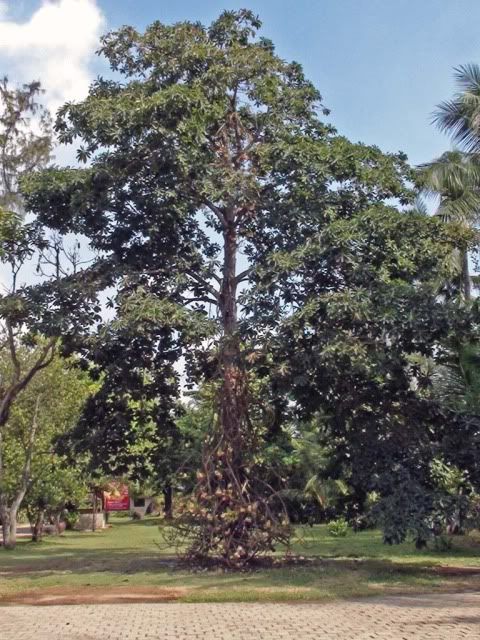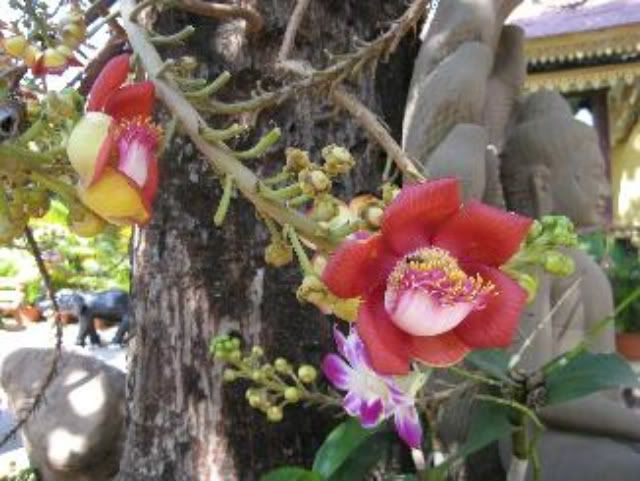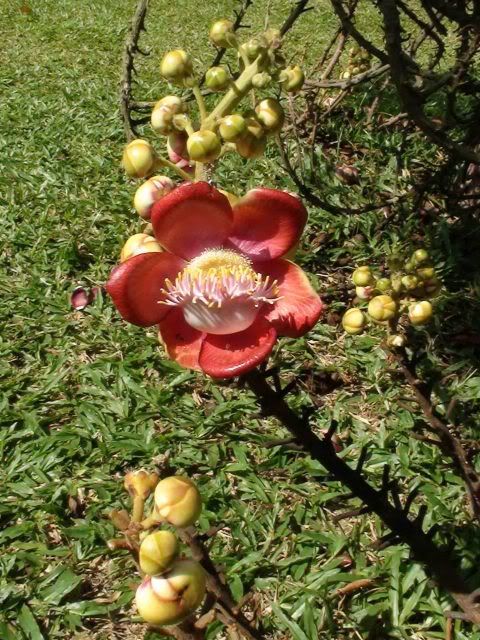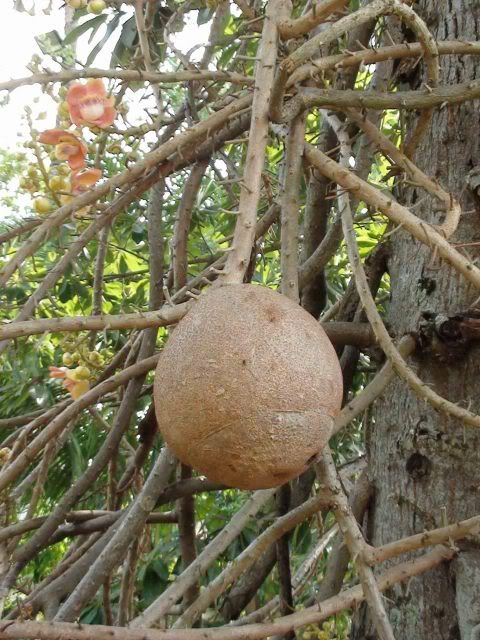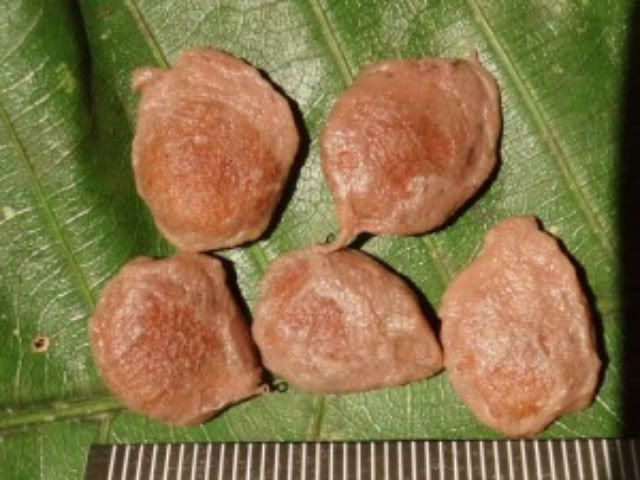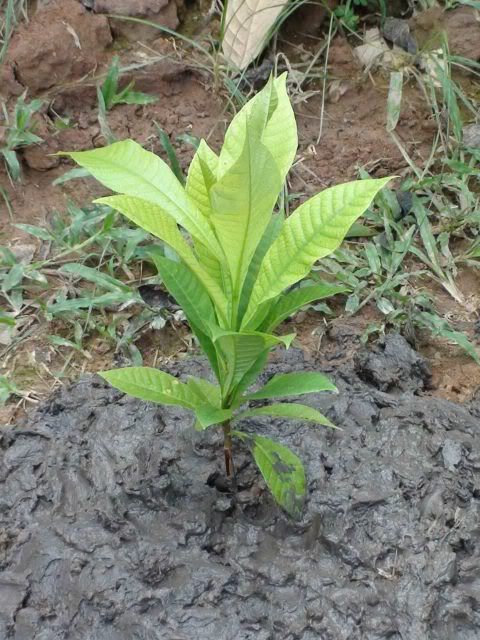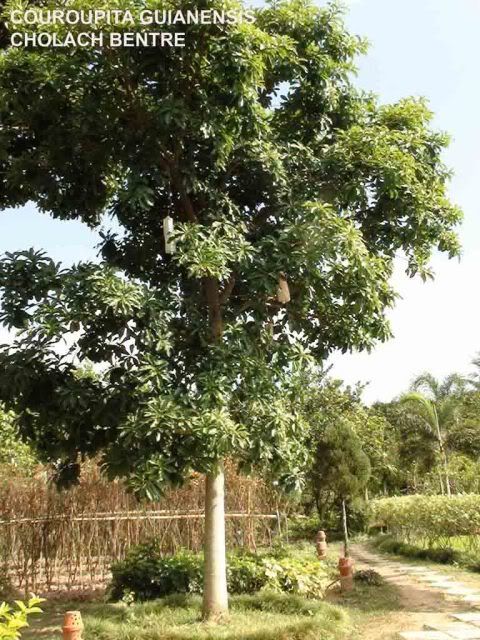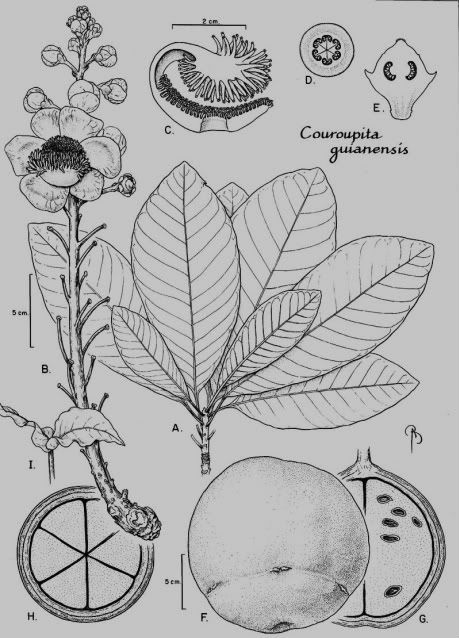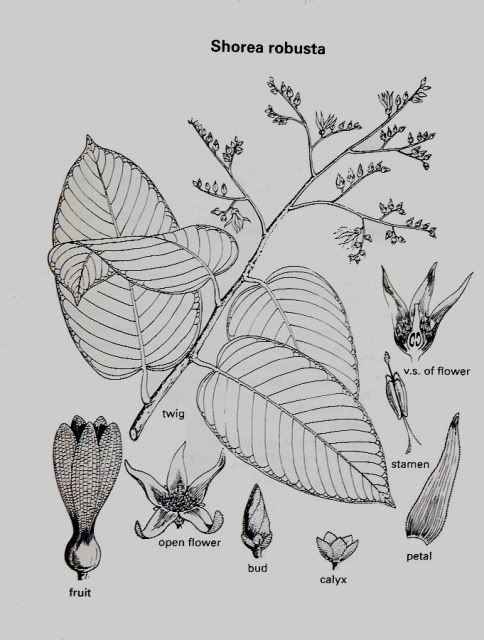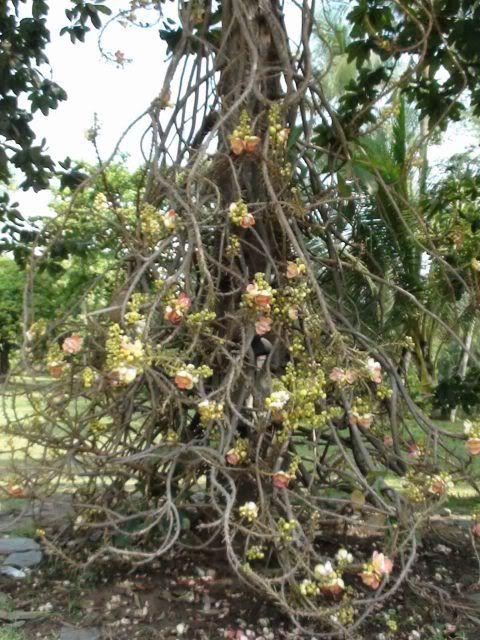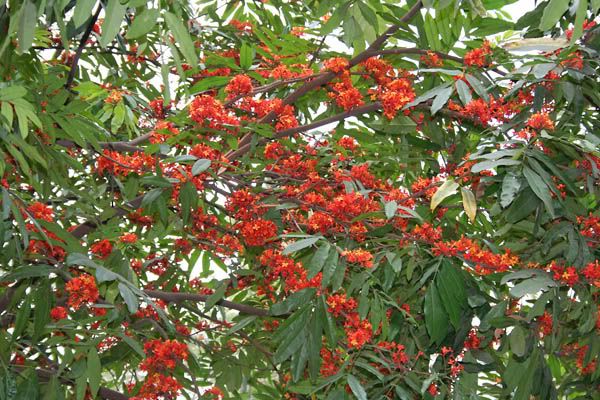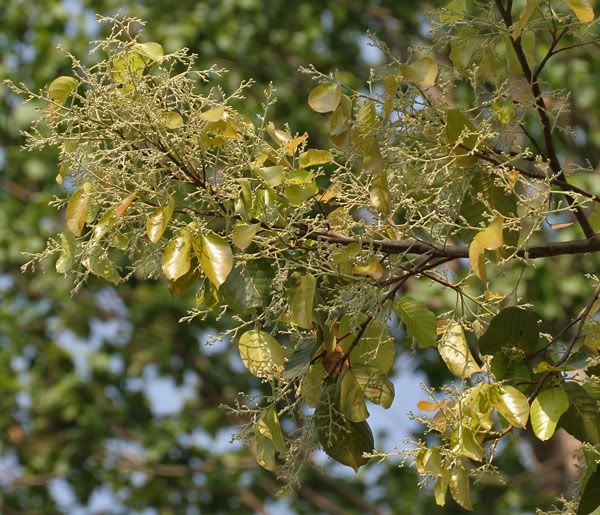Ngọc Kỳ Lân – Couroupita guianensis
Vô Ưu – Saraca asoca
(nơi Phật đản sanh) ??
Sa La – Shorea Robusta
(nơi Phật nhập Niết Bàn) ??
http://thieulang.free.fr/blog/Vô Ưu – Saraca asoca
(nơi Phật đản sanh) ??
Sa La – Shorea Robusta
(nơi Phật nhập Niết Bàn) ??
Tên khoa học: Couroupita guianensis
Họ: Lecythidaceae - Lộc vừng, Chiếc
Cây còn có tên Cannon ball-tree, Arbres à bombes, nguồn gốc ở Nam Mỹ, (xem Guides des plantes tropicales – J.G. Rohwer, trang 96).
Trong quyển Botanica, (Encyclopédie de botanique et d’horticulture – Konemann -1997 , trang 261), mô tả có ba loại Couroupita, trong đó chỉ có C. Guianensis là hoa có mùi thơm.
Ở Việt Nam, cộng đồng Phật giáo, gọi Couroupita là cây Sala, Sala Song Thọ, hay Vô Ưu, thường được trồng trong các chùa.
Căn cứ trên hình dáng hoa, người miền Bắc thường hay gọi là Hàm Rồng. Giáo sư Phạm Hoàng Hộ, gọi là cây Đầu Lân (Cây cỏ Miền Nam, 1970, quyển 1, trang 917). Giới sưu tập cây cảnh thường sử dụng tên Ngọc Kỳ Lân.
Bên Campuchia, trồng nhiều cây này, có thể tìm thấy trong thành phố Siemreap, trong Hoàng Cung, và phía sau Chùa Vàng Chùa Bạc, thấy ghi tên là Shorea Robusta Roxb (!?)
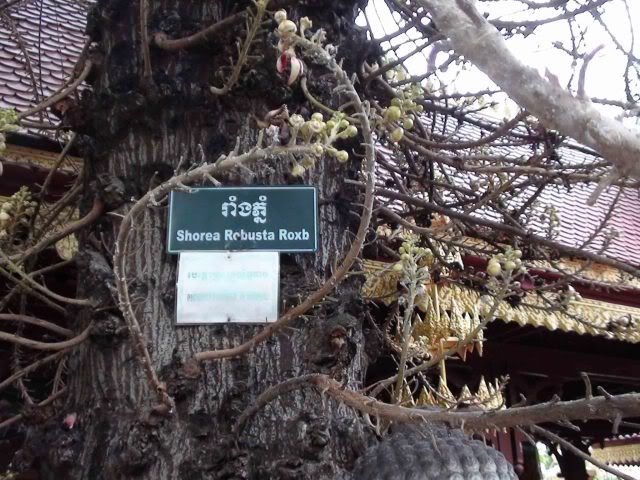
H2. Cây Ngọc Kỳ Lân,
BỊ GHI LẦM
tên thực vật là
Shorea robusta (do ông Roxburgh tìm ra)
TÊN THẬT PHẢI LÀ
Couroupita guianensis
ở phía sau Chùa Vàng Chùa Bạc, Campuchia
(ảnh TL)
Có đăng hình, kèm lời giới thiệu :
Une fleur, que vous pourrez admirer dans le jardin
du palais royal de Phnom Penh :
Couroupita guianensis
(Một loài hoa mà bạn có thể ngắm trong
Ngự Uyễn Hoàng Cung Phnom Penh :
Couroupita guinensis)
du palais royal de Phnom Penh :
Couroupita guianensis
(Một loài hoa mà bạn có thể ngắm trong
Ngự Uyễn Hoàng Cung Phnom Penh :
Couroupita guinensis)
Couroupita guianensis, loại Đại thụ hạng trung bình, thuộc vùng nhiệt đới, có thể cao đến 35 m, thân thẳng, tàn lá tròn. Hoa lưỡng trắc, cành hoa mọc từ trong thân, thòng dài tận dưới gốc, nở quanh năm, có mùi thơm huyền bí, nhất là về đêm cho đến sáng sớm.
Trái, kích cở như quả đạn đại bác thời xưa, do đó có tên gọi Cannon ball-tree, Arbre à bombes hay Arbre à boulets de canon.
Nhân giống, thông thường bằng gieo hạt.
Theo ghi nhận của một nghệ nhân ở Chợ Lách Bến Tre, từ khi trồng cây con, cao khoảng 30 cm, cây phát hoa sau bốn năm, trong điều kiện chăm sóc bình thường.
Ngọc Kỳ Lân thay lá vào đầu mùa mưa, và trổ hoa quanh năm.
Cũng có thể xử lý cho Ngọc Kỳ Lân ra hoa theo ý muốn. Từ khi xử lý tới lúc có hoa là khoảng một tháng rưỡi.
Có nhiều tài liệu nói về hoa Vô ưu, Uư đàm, Sa la, trong truyền thuyết kinh điển Phật giáo, cho thấy có sự liên quan mơ hồ về các tên gọi khác nhau của cây Couroupita guianensis : Ngọc kỳ lân, Sala, Vô ưu, Shorea robusta.
Tương truyền, Thái tử Shidarta ra đời dưới gốc cây Vô Ưu, và nhập Niết Bàn tại rừng Sala đang trổ hoa..
Tác giả Nguyễn Tường Bách trong du ký Mùi Hương Trầm, và Ông Nhất Hạnh trong quyển Đường Xưa Mây Trắng có nói đến cây Sala bên Ấn Độ.
Xin trích dẫn :
Trong “Đường xưa mây trắng”:
« Khi Bụt và các vị khất sĩ tới được rừng Sala thì trời đã xế chiều.
Bụt bảo thầy Ananda soạn chỗ nằm cho Bụt giữa hai cây Sala, rồi Bụt nằm xuống trong thế sư tử tọa, đầu hướng về phương Bắc. Các vị khất sĩ chia nhau ngồi bao quanh Bụt.
Họ biết nội trong đêm nay, tại rừng Sala nầy, Bụt sẽ nhập niết bàn.
Bụt đưa mắt nhìn rừng cây rồi nói với Ananda:
- Nầy Ananda, thầy hãy nhìn xem, bây giờ đâu phải là mùa hoa, mà những cây Sala này đang nở hoa trắng xóa. (trang 561)
Trong Mùi Hương Trầm :
« … Tôi đã đi qua miền rừng núi Bihar và Bắc Ấn, đó là rừng già Ấn Độ mà loại cây thường gặp là Sala, … » (trang 92) …
« … Tôi từ Gorakhpur đến Câu-thi-na vào một chiều mưa, rừng cây Sala ( tên khoa học là Shorea robusta, chú thích của tác giả ) ngày nay vẫn còn, lá xanh ngắt đẫm nước trông như ngọc… » (trang 122)
«…Về phía tây bắc thành phố độ 3,4 dậm vượt qua sông Ajitavati, về phía bờ tây không xa lắm, chúng tôi đến một khu rừng có cây Sala. Cây Sala, như cây Huk, vỏ cây màu trắng xanh, lá lóng lánh và trơn dịu …» (trang 123)
«… Hởi các cây Sala này, theo kinh điển thì tiền bối của các ngươi cũng đã chứng kiến phút nhập diệt của Phật ….» (trang 126).
Trên bình diện thực vật học, theo Dictionnaire classique d’histoire naturelle - Vol 15, cây Shorea Robusta, thường gọi Sal, Shal, Sala, có nguồn gốc bên Ấn độ, thuộc họ Dipterocarpaceae, do nhà thực vật Roxburgh tìm ra, nên mang tên Shorea Robusta Roxb.

H7. Chi tiết thực vật học cây Shorea robusta
nguồn fr.wikipedia.org
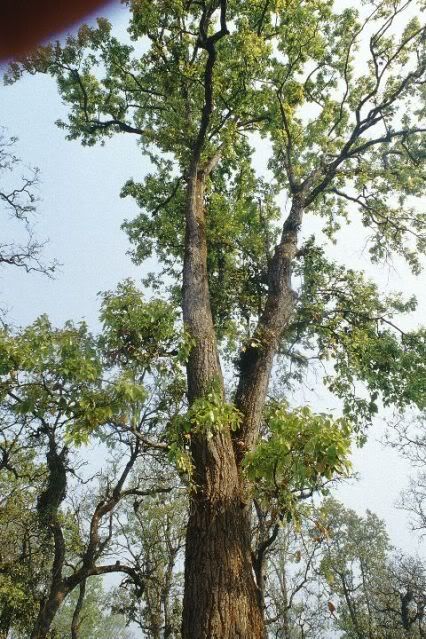
H8. Shorea robusta Roxb

H9. Hoa và lá Shorea robusta
Như vậy,
cây Ngọc Kỳ Lân,
Couroupita guianensis- họ Lecythidaceae,
và
cây Sala,
Shorea Robusta – họ Dipterocarpaceae,
là
hai cây hoàn toàn khác nhau.
cây Ngọc Kỳ Lân,
Couroupita guianensis- họ Lecythidaceae,
và
cây Sala,
Shorea Robusta – họ Dipterocarpaceae,
là
hai cây hoàn toàn khác nhau.
Trong du ký Mùi Hương Trầm nói trên, ông Nguyễn Tường Bách có đến tận rừng cây Sala, và ông chú thích, Sala tên khoa học là Shorea Robusta. Điều này, phù hợp với truyền thuyết khi Phật nhập niết bàn, « cây Sala nở hoa trắng xóa », mà Ông Nhất Hạnh viết trong Đường Xưa Mây Trắng.
Do đó, cây Ngọc Kỳ Lân, Đầu Lân, hoặc Hàm Rồng, có tên thực vật là Couroupita guianensis, hoàn toàn khác với cây truyền thuyết Sala, hay Vô Ưu.
Dù sao, thật không phí công, của, và không gì ấn tượng bằng, có một cây Ngọc Kỳ Lân trước nhà hay trong vườn cảnh.
ThieuLang.

Common name
Cannonball tree, boskalebas, coco de mono, abricó de macaco, castanha de macaco, cuia de macaco, macacarecuia, sala tree, kanonenkugelbaum.
Family
Lecythidaceae (Brazil-nut family).
Overview
A large deciduous tropical tree 90' tall and indigenous to the Amazon rainforest.The leaves, up to 6" long, are simple with serrate margin; it flowers in racemes; the yellow, reddish and pink flowers are stunning fragrant.
There are large 3" to 5" waxy aromatic smelling, pink and dark-red flowers, growing directly on the bark of the trunk (cauliflory).
Pollination is done by bees and bats.
The tree bears, also directly on the trunk and main branches, large globose woody fruits; they look like big rusty cannonballs hanging in clusters, like balls on a string.
The fruit contains small seeds in a white, unpleasant smelling edible jelly, which are exposed when the upper half of the fruit goes off like a cover.
The long dangling fruity branches give the tree an unkempt appearance.
The hard shells are used to make containers and utensils.
Medicinal applications
The fruit pulp, bark and flowers are used for medicinal applications and have antimicrobial- and fungal activity.
Hardiness
USDA zone 9B - 11.
Propagation
Seeds.
Due to recalcitrant nature of the seeds, they have a short viable life, cannot be dried well and cannot withstand low temperatures.
Culture
Full sun / partial shade, moist soil, needs high humidity.
Very susceptible to frost. Plant in frost free locations.
Dưới đây là ảnh rinh về từ
http://biengbiec.multiply.com/journal/item/638/638


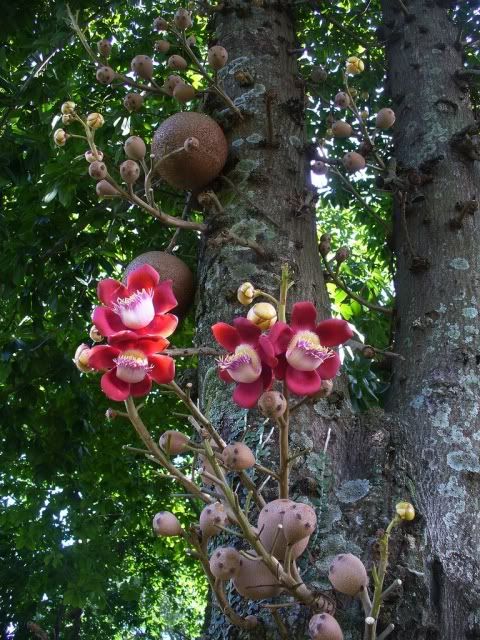
và
Bạn ta với hoa Ngọc Kỳ Lân
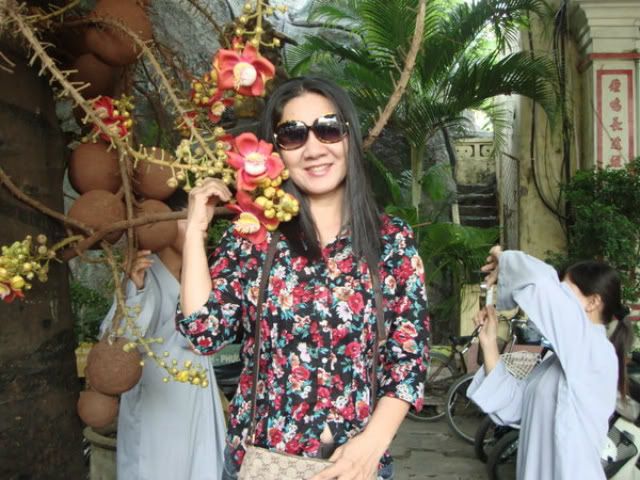
***************************************************************
CÂY VÔ ƯU - ASHOKA
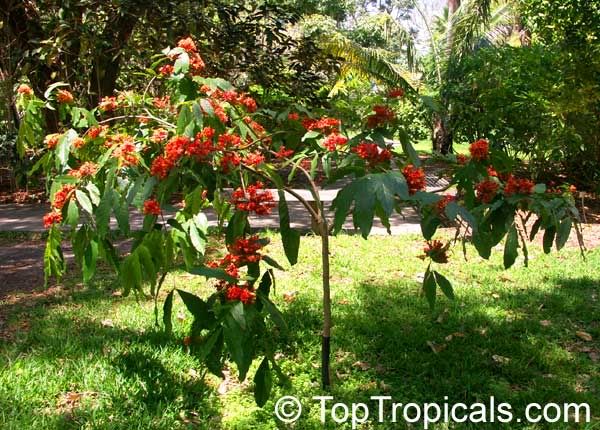
Ashoka tree
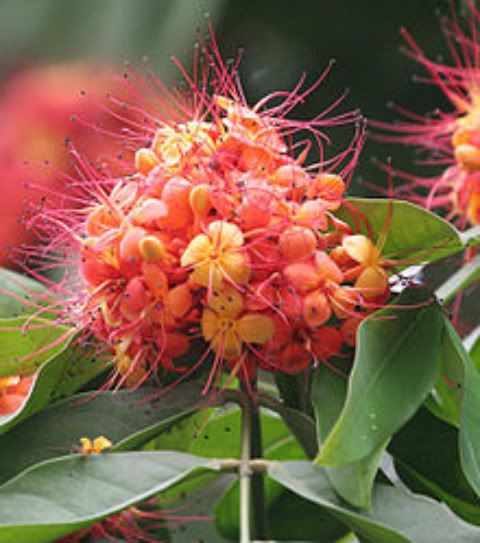
Ashoka flower bunch

http://www.tropilab.com/couroupita.html
COUROUPITA GUIANENSIS - CANNONBALL TREE
Common name
Cannonball tree, boskalebas, coco de mono, abricó de macaco, castanha de macaco, cuia de macaco, macacarecuia, sala tree, kanonenkugelbaum.
Family
Lecythidaceae (Brazil-nut family).
Overview
A large deciduous tropical tree 90' tall and indigenous to the Amazon rainforest.The leaves, up to 6" long, are simple with serrate margin; it flowers in racemes; the yellow, reddish and pink flowers are stunning fragrant.
There are large 3" to 5" waxy aromatic smelling, pink and dark-red flowers, growing directly on the bark of the trunk (cauliflory).
Pollination is done by bees and bats.
The tree bears, also directly on the trunk and main branches, large globose woody fruits; they look like big rusty cannonballs hanging in clusters, like balls on a string.
The fruit contains small seeds in a white, unpleasant smelling edible jelly, which are exposed when the upper half of the fruit goes off like a cover.
The long dangling fruity branches give the tree an unkempt appearance.
The hard shells are used to make containers and utensils.
Medicinal applications
The fruit pulp, bark and flowers are used for medicinal applications and have antimicrobial- and fungal activity.
Hardiness
USDA zone 9B - 11.
Propagation
Seeds.
Due to recalcitrant nature of the seeds, they have a short viable life, cannot be dried well and cannot withstand low temperatures.
Culture
Full sun / partial shade, moist soil, needs high humidity.
Very susceptible to frost. Plant in frost free locations.
Dưới đây là ảnh rinh về từ
http://biengbiec.multiply.com/journal/item/638/638



và
Bạn ta với hoa Ngọc Kỳ Lân

***************************************************************
CÂY VÔ ƯU - ASHOKA

Ashoka tree

Ashoka flower bunch
Conservation status
Vulnerable (IUCN 2.3)Scientific classification
Kingdom: PlantaeOrder: FabalesFamily: FabaceaeGenus: SaracaSpecies: S. asocaBinomial name: Saraca asoca (Roxb.) WildeSynonyms: Saraca indica LinnaeusSaraca asoca (the Ashoka tree; lit., "sorrow-less") is a plant belonging to the Caesalpiniaceae subfamily of the legume family. It is an important tree in the cultural traditions of the Indian Subcontinent and adjacent areas.Description
Leaves & flowers in Kolkata, West Bengal, India.
The Ashoka is a rain-forest tree. Its original distribution was in the central areas of the Deccan plateau, as well as the middle section of the Western Ghats in the western coastal zone of the Indian Subcontinent.
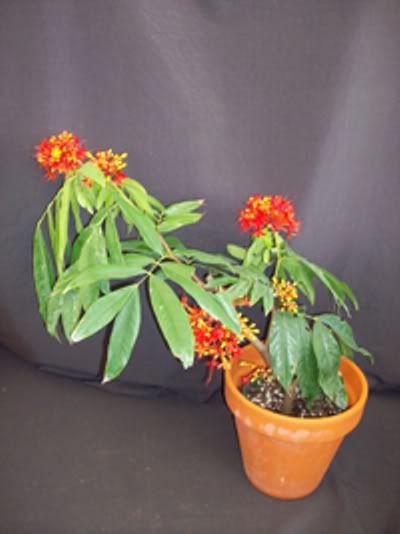
The Ashoka is prized for its beautiful foliage and fragrant flowers. It is a very handsome, small, erect evergreen tree, with deep green leaves growing in dense clusters.
Its flowering season is around February to April. The Ashoka flowers come in heavy, lush bunches. They are bright orange-yellow in color, turning red before wilting.
There are a few varieties of the Ashoka tree. One variety is larger and highly spreading. The columnar varieties are common in cultivation.
The origin of the name Saraca indica is doubtful and it can hardly be claimed to be an improvement on the old one of Jonesia asoka, given by Indian botanists to honour Sir W. Jones " the most enlightened of the sons of men," who himself expressed the wish that the tree should retain the old Sanskrit name Ashoka.
Indigenous to India, Burma and Malaya, it is an erect tree, small and evergreen, with a smooth, grey-brown bark. The crown is compact and shapely.
Flowers are usually to be seen throughout the year, but it is in January and February that the profusion of orange and scarlet clusters turns the tree into an object of startling beauty. Pinned closely on to every branch and twig, these clusters consist of numerous, small, long-tubed flowers which open out into four oval lobes. Yellow when young, they become orange then crimson with age and from the effect of the sun's rays. From a ring at the top of each tube spread several long, half-white, half-crimson, stamens which give an hairy appearance to the flower clusters. In strong contrast to these fiery blooms is the deep-green, shiny foliage. The foot-long leaves each have four, five or six pairs of long, wavy-edged, leaflets. Young leaves are soft, red and limp and remain pendent even after attaining full size.The straight or scimitar shaped pods, stiff, leathery, broad and about eight inches long, are red and fleshy before ripening.Religious significance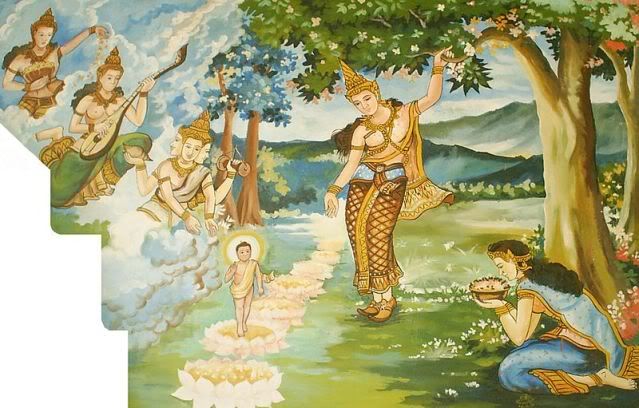
Queen Māyā giving birth to the Buddha
In Buddhist tradition, it is said that Queen Māyā of Sakya gave birth to Gautama Buddha under a sal tree or an asoka tree in a garden in Lumbini, in south Nepal, while grasping its branch. When this event took place, Queen Māyā was en route to birth him in his grandfather's kingdom.
Vulnerable (IUCN 2.3)Scientific classification
Kingdom: PlantaeOrder: FabalesFamily: FabaceaeGenus: SaracaSpecies: S. asocaBinomial name: Saraca asoca (Roxb.) WildeSynonyms: Saraca indica LinnaeusSaraca asoca (the Ashoka tree; lit., "sorrow-less") is a plant belonging to the Caesalpiniaceae subfamily of the legume family. It is an important tree in the cultural traditions of the Indian Subcontinent and adjacent areas.Description
Leaves & flowers in Kolkata, West Bengal, India.
The Ashoka is a rain-forest tree. Its original distribution was in the central areas of the Deccan plateau, as well as the middle section of the Western Ghats in the western coastal zone of the Indian Subcontinent.

The Ashoka is prized for its beautiful foliage and fragrant flowers. It is a very handsome, small, erect evergreen tree, with deep green leaves growing in dense clusters.
Its flowering season is around February to April. The Ashoka flowers come in heavy, lush bunches. They are bright orange-yellow in color, turning red before wilting.
There are a few varieties of the Ashoka tree. One variety is larger and highly spreading. The columnar varieties are common in cultivation.
The origin of the name Saraca indica is doubtful and it can hardly be claimed to be an improvement on the old one of Jonesia asoka, given by Indian botanists to honour Sir W. Jones " the most enlightened of the sons of men," who himself expressed the wish that the tree should retain the old Sanskrit name Ashoka.
Indigenous to India, Burma and Malaya, it is an erect tree, small and evergreen, with a smooth, grey-brown bark. The crown is compact and shapely.
Flowers are usually to be seen throughout the year, but it is in January and February that the profusion of orange and scarlet clusters turns the tree into an object of startling beauty. Pinned closely on to every branch and twig, these clusters consist of numerous, small, long-tubed flowers which open out into four oval lobes. Yellow when young, they become orange then crimson with age and from the effect of the sun's rays. From a ring at the top of each tube spread several long, half-white, half-crimson, stamens which give an hairy appearance to the flower clusters. In strong contrast to these fiery blooms is the deep-green, shiny foliage. The foot-long leaves each have four, five or six pairs of long, wavy-edged, leaflets. Young leaves are soft, red and limp and remain pendent even after attaining full size.The straight or scimitar shaped pods, stiff, leathery, broad and about eight inches long, are red and fleshy before ripening.Religious significance

Queen Māyā giving birth to the Buddha
In Buddhist tradition, it is said that Queen Māyā of Sakya gave birth to Gautama Buddha under a sal tree or an asoka tree in a garden in Lumbini, in south Nepal, while grasping its branch. When this event took place, Queen Māyā was en route to birth him in his grandfather's kingdom.
Sa La - Shorea robusta
http://en.wikipedia.org/wiki/Shorea_robusta
http://en.wikipedia.org/wiki/Shorea_robusta
Conservation status Least Concern (IUCN 2.3)Scientific classification
Kingdom: PlantaeOrder: MalvalesFamily: DipterocarpaceaeGenus: ShoreaSpecies: S. robustaBinomial name: Shorea robusta
Kingdom: PlantaeOrder: MalvalesFamily: DipterocarpaceaeGenus: ShoreaSpecies: S. robustaBinomial name: Shorea robusta
Shorea robusta, also known as sal or shala tree, is a species of tree belonging to the Dipterocarpaceae family.Distribution and description
New leaves with flower buds at Jayanti in Buxa Tiger Reserve in Jalpaiguri district of West Bengal, India.
This tree is native to southern Asia, ranging south of the Himalaya, from Myanmar in the east to Nepal, India and Bangladesh. In Nepal, it is found mostly in the terai region from east to west, especially, in the Churia range (the Shivalik Hill Churia Range) in the subtropical climate zone. There are many protected areas, such as Chitwan National Park, Bardiya National Park Bardia National Park, Shukla Phat National Parks, etc., where there are dense forests of huge sal trees. It is also found in the lower belt of the hilly region and inner terai. In India, it extends from Assam, Bengal, Orissa and Jharkhand west to the Shivalik Hills in Haryana, east of the Yamuna. The range also extends through the Eastern Ghats and to the eastern Vindhya and Satpura ranges of central India. It is often the dominant tree in the forests where it occurs.
Sal is moderate to slow growing, and can attain heights of 30 to 35 m and a trunk diameter of up to 2-2.5 m. The leaves are 10–25 cm long and 5–15 cm broad. In wetter areas, it is evergreen; in drier areas, it is dry-season deciduous, shedding most of the leaves in between February to April, leafing out again in April and May.
New leaves with flower buds at Jayanti in Buxa Tiger Reserve in Jalpaiguri district of West Bengal, India.
This tree is native to southern Asia, ranging south of the Himalaya, from Myanmar in the east to Nepal, India and Bangladesh. In Nepal, it is found mostly in the terai region from east to west, especially, in the Churia range (the Shivalik Hill Churia Range) in the subtropical climate zone. There are many protected areas, such as Chitwan National Park, Bardiya National Park Bardia National Park, Shukla Phat National Parks, etc., where there are dense forests of huge sal trees. It is also found in the lower belt of the hilly region and inner terai. In India, it extends from Assam, Bengal, Orissa and Jharkhand west to the Shivalik Hills in Haryana, east of the Yamuna. The range also extends through the Eastern Ghats and to the eastern Vindhya and Satpura ranges of central India. It is often the dominant tree in the forests where it occurs.
